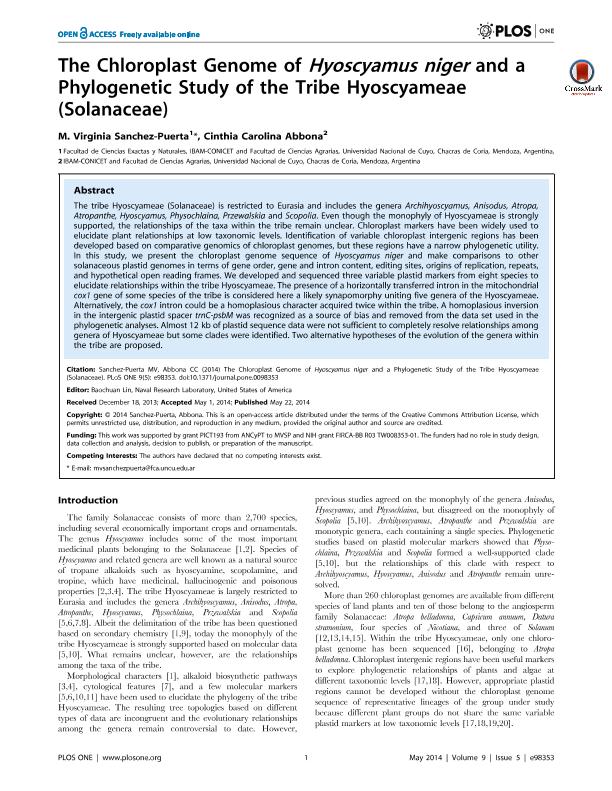Mostrar el registro sencillo del ítem
dc.contributor.author
Sánchez Puerta, María Virginia

dc.contributor.author
Abbona, Cinthia Carolina

dc.date.available
2020-05-06T18:24:32Z
dc.date.issued
2014-05
dc.identifier.citation
Sánchez Puerta, María Virginia; Abbona, Cinthia Carolina; The chloroplast genome of Hyoscyamus niger and a phylogenetic study of the tribe Hyoscyameae (Solanaceae); Public Library of Science; Plos One; 9; 5-2014; 1-10; e98353
dc.identifier.issn
1932-6203
dc.identifier.uri
http://hdl.handle.net/11336/104382
dc.description.abstract
The tribe Hyoscyameae (Solanaceae) is restricted to Eurasia and includes the genera Archihyoscyamus, Anisodus, Atropa, Atropanthe, Hyoscyamus, Physochlaina, Przewalskia and Scopolia. Even though the monophyly of Hyoscyameae is strongly supported, the relationships of the taxa within the tribe remain unclear. Chloroplast markers have been widely used to elucidate plant relationships at low taxonomic levels. Identification of variable chloroplast intergenic regions has been developed based on comparative genomics of chloroplast genomes, but these regions have a narrow phylogenetic utility. In this study, we present the chloroplast genome sequence of Hyoscyamus niger and make comparisons to other solanaceous plastid genomes in terms of gene order, gene and intron content, editing sites, origins of replication, repeats, and hypothetical open reading frames. We developed and sequenced three variable plastid markers from eight species to elucidate relationships within the tribe Hyoscyameae. The presence of a horizontally transferred intron in the mitochondrial cox1 gene of some species of the tribe is considered here a likely synapomorphy uniting five genera of the Hyoscyameae. Alternatively, the cox1 intron could be a homoplasious character acquired twice within the tribe. A homoplasious inversion in the intergenic plastid spacer trnC-psbM was recognized as a source of bias and removed from the data set used in the phylogenetic analyses. Almost 12 kb of plastid sequence data were not sufficient to completely resolve relationships among genera of Hyoscyameae but some clades were identified. Two alternative hypotheses of the evolution of the genera within the tribe are proposed.
dc.format
application/pdf
dc.language.iso
eng
dc.publisher
Public Library of Science

dc.rights
info:eu-repo/semantics/openAccess
dc.rights.uri
https://creativecommons.org/licenses/by-nc-sa/2.5/ar/
dc.subject
CHLOROPLAST
dc.subject
HYOSCYAMEAE
dc.subject
HYOSCYAMUS NIGER
dc.subject
PHYLOGENY
dc.subject.classification
Biología

dc.subject.classification
Ciencias Biológicas

dc.subject.classification
CIENCIAS NATURALES Y EXACTAS

dc.title
The chloroplast genome of Hyoscyamus niger and a phylogenetic study of the tribe Hyoscyameae (Solanaceae)
dc.type
info:eu-repo/semantics/article
dc.type
info:ar-repo/semantics/artículo
dc.type
info:eu-repo/semantics/publishedVersion
dc.date.updated
2020-04-28T14:33:47Z
dc.journal.volume
9
dc.journal.pagination
1-10; e98353
dc.journal.pais
Estados Unidos

dc.journal.ciudad
San Francisco
dc.description.fil
Fil: Sánchez Puerta, María Virginia. Universidad Nacional de Cuyo. Facultad de Ciencias Exactas y Naturales. Departamento de Biología; Argentina. Consejo Nacional de Investigaciones Científicas y Técnicas. Centro Científico Tecnológico Conicet - Mendoza. Instituto de Biología Agrícola de Mendoza. Universidad Nacional de Cuyo. Facultad de Ciencias Agrarias. Instituto de Biología Agrícola de Mendoza; Argentina. Universidad Nacional de Cuyo. Facultad de Ciencias Agrarias. Departamento de Ciencias Biológicas; Argentina
dc.description.fil
Fil: Abbona, Cinthia Carolina. Consejo Nacional de Investigaciones Científicas y Técnicas. Centro Científico Tecnológico Conicet - Mendoza. Instituto de Biología Agrícola de Mendoza. Universidad Nacional de Cuyo. Facultad de Ciencias Agrarias. Instituto de Biología Agrícola de Mendoza; Argentina
dc.journal.title
Plos One

dc.relation.alternativeid
info:eu-repo/semantics/altIdentifier/url/http://www.plosone.org/article/info%3Adoi%2F10.1371%2Fjournal.pone.0098353
dc.relation.alternativeid
info:eu-repo/semantics/altIdentifier/doi/http://dx.doi.org/10.1371/journal.pone.0098353
Archivos asociados
